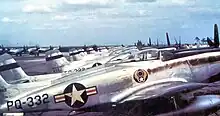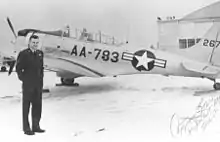Buzz number
Buzz number is a term applied to the large letter and number combination applied to United States Air Force military aircraft in the years immediately after World War II, through the early 1960s. This moniker evolved from aircrew speculation that the large numbers were meant to dissuade "buzzing" (very-low-altitude high-speed passes over populated areas) by increasing the likelihood of being identified and punished.

The first two letters of a buzz number indicated the type and designation of an aircraft while the last three were generally the last three digits of the aircraft serial number. Air Force fighters used buzz numbers starting with the letter F (or P, when fighters were designated as "pursuit" aircraft before June 1948), while bombers started with the letter B. For example, a P-51 Mustang would have a buzz number such as FF-230 while an F-86 Sabre might be FU-910. A B-66 Destroyer would have a buzz number such as BB-222. One of the last Air Force fighters to carry a buzz number was the F-4 Phantom II (FJ), then called the F-110 Spectre by the Air Force.
List of buzz codes



This table lists U.S. Air Force and U.S. Army aircraft by buzz-number prefix. Note that some aircraft types changed prefixes during their career, while other prefixes were re-used after an earlier type was retired.
References
- Citations
- Andrade 1979, p. 249
- Adcock 1992, p.7.
- Johnsen 2006, p.10.
- Johnsen 2006, p.6.
- Sgarlato 1979, p.82.
- Swanborough and Bowers 1989, p.43.
- Hooftman 1965, p.59.
- Kinzey 1990, p.17.
- Johnsen 2006, p.58.
- "North American YF-93". Fact Sheets. National Museum of the United States Air Force. Archived from the original on 2014-10-27. Retrieved 2017-07-09.
{{cite web}}: CS1 maint: bot: original URL status unknown (link)
- Bibliography
- Adcock, Al (1992). C-123 Provider in action. Aircraft In Action. Vol. 124. Carrollton, TX: Squadron/Signal Publications. ISBN 978-0-89747-276-0.
- Andrade, John M. (1979). U.S. Military Aircraft Designations and Serials since 1909. Leichester, UK: Midland Counties Publications. ISBN 0-904597-22-9. Retrieved 2011-02-08.
- Hooftman, Hugo (1965). Russian Aircraft. Fallbrook, CA: Aero Publishers. ISBN 978-0-8168-8100-0. Retrieved 2011-02-08.
- Johnsen, Frederick A. (2006). Northrop F-5/F-20/T-38. WarbirdTech Series. Vol. 44. North Branch, MN: Specialty Press. ISBN 978-1-58007-094-2.
- Kinzey, Bert (1990). F-102 Delta Dagger in Detail & Scale. Detail & Scale. Vol. 35. Carrollton, TX: Squadron/Signal Publications. ISBN 978-0-8306-3046-2. Retrieved 2011-02-08.
- Sgarlato, Nico (1979). USAF Aircraft of Today. Carrollton, TX: Squadron/Signal Publications. ISBN 0-89747-068-0.
- Swanborough, Gordon; Peter M. Bowers (1989). United States Military Aircraft since 1909. Washington, D.C.: Smithsonian Institution Press. ISBN 978-0-87474-880-2.
Douglas XCG-17.
- Further reading
- Bowers, Peter M.; David W. Menard (2006). Buzz Numbers: The Explanations and Regulations Behind America's Military Aircraft Identification System. North Branch, MN: Specialty Press. ISBN 978-1-58007-103-1.